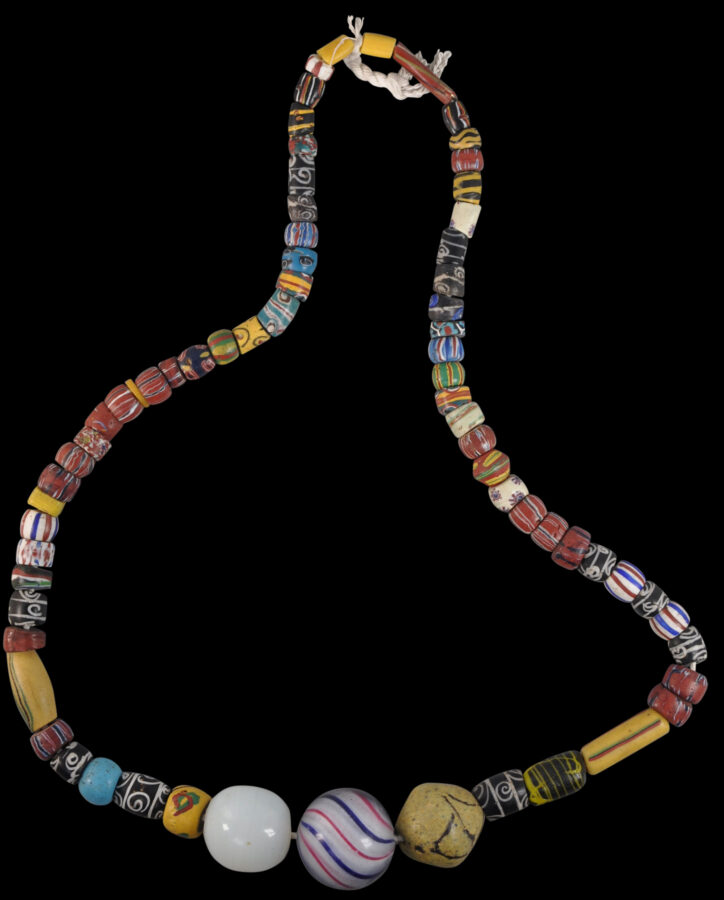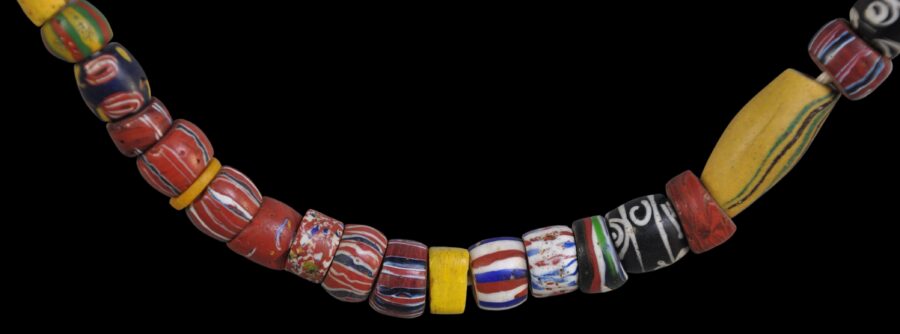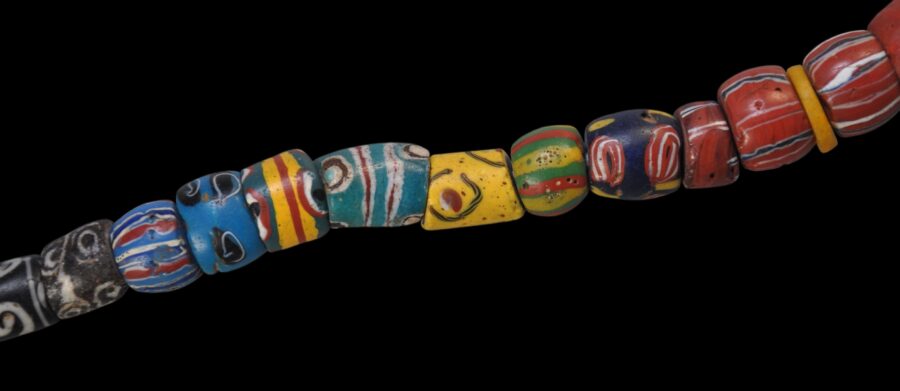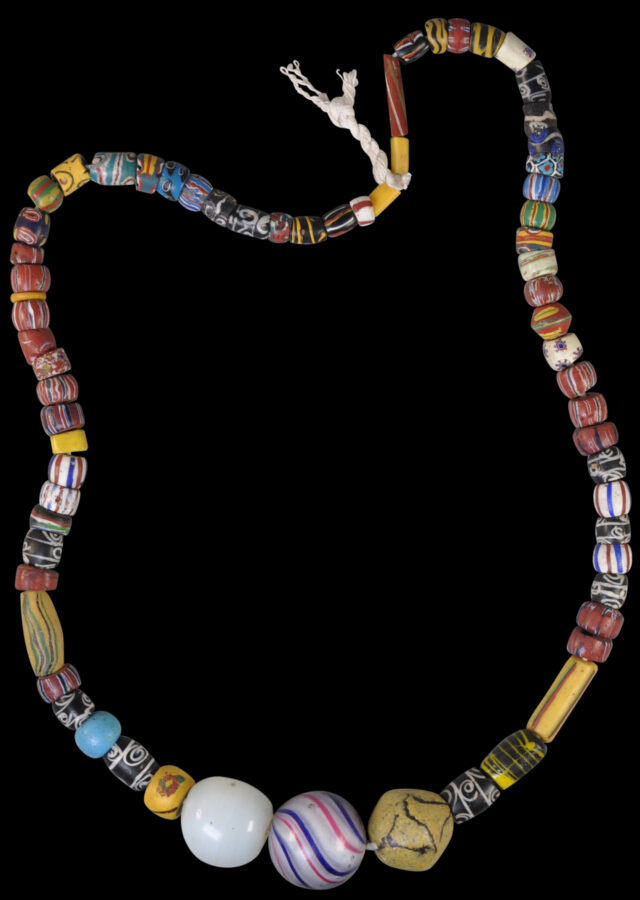Enquiry about object: 9817
Exceptional, Large Strand of European & African Trade Beads for the West African Market
Trade Beads for the West African Market beads date from ancient to circa 1920
circumference: approximately 82cm, diameter of the white core marble bead: 3.8cm, weight: 404g
Provenance
private collection, Canada. The collection was carefully assembled over the last 50 years.
This spectacular strand of 68 beads includes beads from Europe and Africa, from ancient times to the early 20th century. The beads are a mix favoured in West Africa, and most probably the strands was assembled in Ghana. This is an extravagant and showy strand of beads that provides testament to the wealth and status of the past owners.
Beads have been collected everywhere and throughout time, but in Africa, the tradition for acquiring beads for personal adornment has a particularly long history.
A bead-by-bead description of the 68 beads in this strand is provided below. But among those included is a large Lauscha bead in excellent condition. Such beads were produced in Germany around 1870. Known as striped alley or Lauscha beads after the town in which they were produced, the beads feature swirling patterns produced using the latticino technique in which coloured rods of grass are drawn through clear glass.
Also included is a large yellow bicone Bodom or powder glass bead produced in the 19th century in Ghana, and two other related beads. These beads were produced locally from old, crushed glass by the Krobo People. The Krobo people are the largest group of the seven Dangme ethnic groups of South-eastern Ghana. A farming people, they also distinguished themselves with their elaborate bead making.
Another major bead is a large 17th century Dutch white glass ‘moon’ bead of opaline glass, prized by the Yoruba.
A Yoruba necklace that includes European-made ‘moon’ beads is illustrated in Liu (1995, p. 46).
All beads in the strand here are in very fine condition, and each has a patina commensurate with its age.
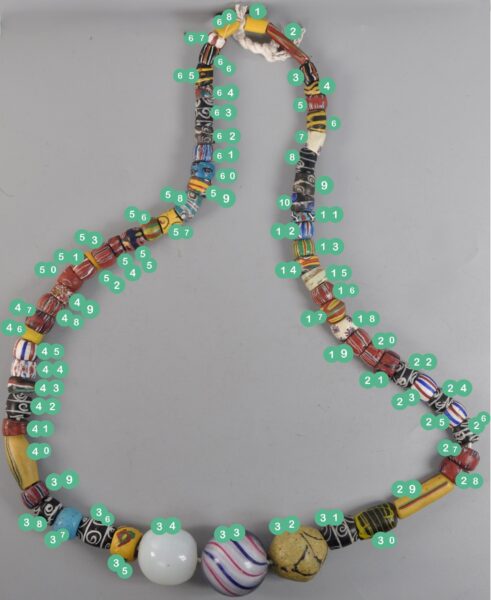
List prepared by Sarah Corbett:
- Yellow glass. No decoration, Hebron, Palestine, called Kano beads. Ancient
- Red glass with applied coloured lampwork lines. Venetian
- Black glass core. Trailed lampwork decoration. Venetian, 1900
- Black glass core with yellow trailed lampwork. Venetian, 1900
- Red glass core with worn lampwork stripes. Venetian, 1880
- Black glass core with yellow trailed lampwork. Venetian, 1900
- White glass core with millefiori slices, Venetian, 1900
- Black glass core with white trailed designs, Venetian, called zen bead, 1900
- Black glass core with white trailed designs, Venetian, called a zen bead, 1900
- Black glass core with white trailed designs plus applied blue eyes, Venetian, a rarer style 1900
- Black glass core with applied millefiori Millefiori bead, Venetian 1920
- Pale blue glass core with trailed lampwork decoration. Venetian, a rarer style 1900
- Green glass core with trailed lampwork decoration. Venetian, a rarer style, 1920
- Teal glass core with trailed lampwork decoration. Venetian, 1930
- White glass core with trailed lampwork decoration. Venetian, 1900
- Red glass core with worn lampwork stripes. Venetian, 1880
- Red glass core with trailed lampwork decoration. Venetian known as a king bead. 1900
- White glass core with millefiori slices. Venetian, 1900
- Red glass core with worn lampwork stripes. Venetian, 1880
- Red glass core with worn lampwork stripes. Venetian, 1880
- Red glass core with worn lampwork stripes. Venetian, 1880
- Black glass core with white trailed designs. Venetian, called a zen bead, 1900
- White glass core Red and blue trailed design. Venetian called a flag bead, 1900
- Black glass core White trailed designs. Venetian, called a zen bead, 1900
- White glass core Red and blue trailed design. Venetian called a flag bead, 1900
- Black glass core with white trailed designs. Venetian, called a zen bead, 1900
- Red glass core with worn lampwork stripes. Venetian, 1880
- Red glass core with worn lampwork stripes. Venetian, 1880
- Yellow glass core with lampwork stripes. Venetian, 1900
- Black glass core with yellow trailed lampwork. Venetian, 1900
- Black glass core with white trailed designs. Venetian, called zen bead 1900
- Powder glass core. Black powder glass designs. Ghana. 1800s
- White core marble bead, Germany, 1800s
- White glass, wound glass European, often called a Yoruba moon bead, 1600s
- Black core, yellow outer and red and green applied decoration. Akko’s bead, Ghana, 1800s
- Black glass core with white trailed designs. Venetian, called zen bead, 1900
- Blue glass with white glass. Wound glass. European, often called a Yoruba moon bead, 1600s
- Black glass core with white trailed designs. Venetian, called a zen bead, 1900
- Red glass core with worn lampwork stripes. Venetian, 1880
- Yellow Akoso bead, Ghana (Africa), circa 1900
- Wound glass bead, European, circa 1800
- Black glass core with white trailed designs. Venetian, called zen bead, 1900
- Black glass core with lampwork glass designs. Venetian, 1900
- Red glass core with lampwork glass designs. Venetian, 1880
- White glass core Red and blue trailed design. Venetian called flag bead, 1900
- Yellow glass. No decoration. Hebron , Palestine called Kano beads. Ancient
- Red glass core with worn lampwork stripes. Venetian, 1880
- Red glass core with worn lampwork stripes. Venetian, 1880
- Red glass core with worn lampwork stripes. Venetian, 1880
- Red glass core with worn lampwork stripe. Venetian, 1880
- Red glass core with worn lampwork stripes. Venetian, 1880
- Yellow glass No decoration. Hebron, Palestine called Kano beads. Ancient
- Red glass core with worn lampwork stripes Venetian, 1880
- Red glass core with worn lampwork stripes Venetian, 1880
- Black glass core with lampwork designs Venetian, 1900
- Green glass core with lampwork stripes Venetian, 1900
- Yellow glass core with lampwork eye designs Venetian, 1880
- Blue glass core with lampwork designs Venetian, 1900
- Blue glass core with lampwork designs Venetian, 1900
- Blue glass core with lampwork eye designs Venetian, 1900
- Blue glass core with lampwork stripes Venetian, 1900
- Black glass core with white trailed designs. Venetian, called zen bead, 1900
- Black glass core with white trailed designs. Venetian, called zen bead, 1900
- Mixed glass, crumb bead. Venetian end of day glass, 1920
- Black glass core with trailed lampwork decoration. Venetian, 1920
- Black glass core with trailed lampwork decoration. Venetian, 1900
- White glass core with red trailed glass stripes. Venetian, 1900
- Yellow glass. No decoration, Hebron, Palestine. Named Kano beads. Ancient
References
Sarah Corbett, personal communication.
Liu, R.K., A Universal Aesthetic: Collectible Beads, Ornament, Inc, 1995.
Sherr Dubin, L., The Worldwide History of Beads, Thames & Hudson, 2009.
Steinberg, B., & J.D. Allen, Wild Beads of Africa: Old Powderglass Beads from the Collection of Billy Steinberg, Steinberg, 2017.


